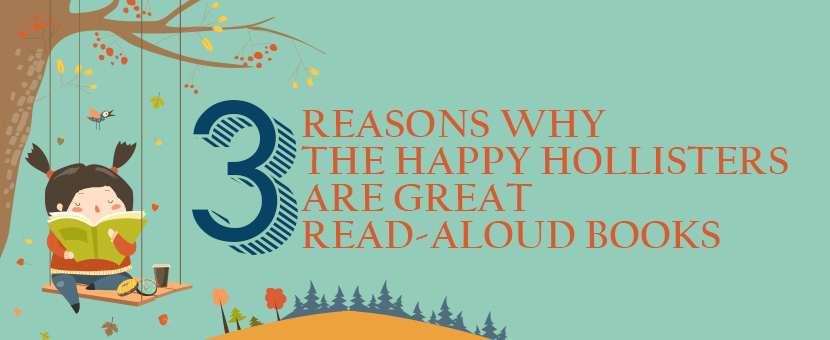Three Reasons Why The Happy Hollisters Are Great Read-Aloud Books
The Happy Hollisters by Jerry West makes great read-aloud stories for your little ones. Preschoolers benefit from having books read aloud to them, and older children who are learning to read on their own will strengthen their reading abilities through listening.
1) Quality Time with Loved Ones
At the end of a busy day, settling down with a good book is relaxing, no matter what your age. If your kids have been on the run all day with play dates, school, homework, and sports, 30 minutes of quiet time with bedtime stories can help them transition to drowsiness. There’s nothing like snuggling together in bed or a cozy chair for read-aloud time with someone special. These adventures are exciting, but not so much your children will be too wound up to sleep, and the stories aren’t overly scary. Little ones won’t be too frightened to sleep after hearing a chapter.
Every Happy Hollisters book contains 18 chapters, perfect for chapter-a-day reading. Chapters are typically 8-10 pages long, in an easy-to-read font, so reading isn’t a strain for older eyes. Illustrations by artist Helen S. Hamilton—at least one per chapter—help bring the characters and story to life. Stopping for a few minutes to talk about the pictures gives you a chance to catch your breath. You might also ask children to describe what is happening in the picture, helping them verbalize and show that they understand the story so far.
2) Teaching Moments
The Happy Hollisters were originally written between 1953 and 1969, and the stories reflect a more innocent time, the “good old days” that we all lived through somehow—without seatbelts, cell phones, and 24/7 parental supervision. The reissued paperbacks are identical to the original volumes and offer myriad “teaching moments” for today’s readers.
There will be things your kids don’t understand. “What is the big deal about ‘calling long-distance’?” “Why aren’t these kids wearing bike helmets?” This is your chance to talk about history and explain how norms and behaviors have changed over time. Encourage them to ask questions about life in the 1950s and 60s. They will probably enjoy your own stories about what life was like when you were their age.
The vocabulary is great for emerging readers, too. Author Andrew Svenson (“Jerry West” was a pen name) made a point of not “dumbing down” the vocabulary to make the books easier to read. The books are filled with enriching words that kids may not be familiar with—fervent, indignant, suspicious—but once they’ve heard these words read aloud and pronounced correctly, they’re more likely to recognize them when they are reading on their own later. Some words are quaintly old-fashioned—swell, dungarees, handkerchiefs—but add another layer to your child’s vocabulary. You can learn more about the vocabulary in our Talk Like a Happy Hollister blog.
The Hollister children aren’t perfect, occasionally getting into mischief and teasing each other, but for the most part, they are kind to each other, demonstrate high moral values, and are swell role models for today’s children. They speak easily with the adults in their lives and look up respectfully to their parents, teachers, and police officers. In their interactions with the neighborhood bully, Joey Brill, they also learn how to respond to adversity. Sometimes they don’t react in the nicest way, for example, wanting to punch Joey in the nose after he pushes Holly’s face into a dish of ice cream. That’s another good teaching moment: “What could Pete have done differently when Joey did that?”
3) Encourage Young Readers to Become Lifelong Readers
One of the best things about reading aloud is that it encourages your young readers to become lifelong readers. They see that you value words, books, and reading, and they learn to love them too.
Andrew Svenson was primarily a series book writer. (In addition to The Happy Hollisters, he outlined, wrote, or edited many volumes in the Hardy Boys, Nancy Drew, and Bobbsey Twins series.). He felt that reading was important and that “getting hooked” was a good thing. Every chapter he wrote was carefully planned to “set up danger, mystery, and excitement on page one. Force the kid to turn the page . . . Then in the middle of each chapter, there’s a dramatic point of excitement, and at chapter’s end, a cliffhanger.” This formula worked like a charm, and even reluctant readers were drawn in and encouraged to want more of the story.
Even after one book is finished, there are more in the series—33 volumes in all—to keep children engaged and curious. The books can be read in any order (they occasionally refer to adventures they’ve had in previous books, but not in a way that you need to have read that book before moving on to another.)
Young readers who enjoy being read to eventually learn to read on their own, and they keep reading. As they become more comfortable with reading on their own, you can offer them the chance to read aloud to you, and further improve their reading skills. Hopefully, that love of read-aloud time is a special tradition that they will pass down to their children and generations to come.

